Playing sports can often result in aches and pains or an injury that needs to be seen by a sports injury rehab specialist for proper diagnosis and treatment.
Choosing the right sports injury rehab specialist is often one of the most difficult parts of dealing with an injury. The following tips might help you choose if a sports injury rehab specialist is right for you.
What Is Sports Medicine?
Sports medicine is the practice and study of medical principles related to the science of sports, particularly in the areas of:
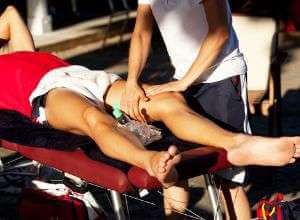
- Sports injury diagnosis and treatment
- Sports injury prevention
- Other specialties may incorporate or emphasize sports training and athletic performance into their respective fields, including:
- Sports nutrition
- Sports psychology
What Is a Sports Injury Rehab Specialist?
A sports injury rehab specialist is an individual with specialized education and training who focuses on the therapeutic and medical aspects of sports participation and physical activity.
Athletes often prefer seeing a sports injury rehab specialist who has experience treating athletes. The best means to find them is to ask for references from other athletes. Local sports teams, clubs, and healthcare organizations should be able to steer you in the right direction. Once you have some recommendations, you will want to double-check their qualifications.
Types of Sports Injuries
While many injuries are minor and could be healed with home remedies, major injuries are serious and need immediate medical attention from a sports injury rehab specialist.
Common sports injuries include:
ACL tears occur when a tear or sprain in the anterior cruciate ligament (ACL), one of the knee’s major ligaments. ACL injuries happen during a sudden stop, change of direction, jumping, or landing. This injury is common in soccer, basketball, football, and skiing sports.
A Concussion is a severe traumatic brain injury that happens when you experience a blow, bump, or jolt to your body or head that leads to a rapid back and forth movement of the brain and head; with this sudden movement, the brain bounces and moves around in your skull which causes chemical changes, stretching, and damage to brain cells.
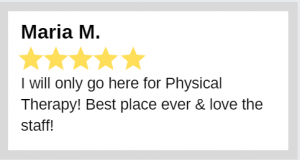
Sprains happen when bands of fibrous tissue connecting two bones known as ligaments stretch or tear. The most sprained area is your ankle.
Strains are different from sprains. Strains occur when an injury to the muscle or tissue attaches muscles to bones.
Shin Splints refer to pain along your tibia, the large bone in front of your lower leg, called the shin bone.
Tennis Elbow is tendon inflammation in your elbow due to overusing the forearm muscles.
Sports Injury Rehabilitation Stages
After initially sustaining a sports injury, it could be easy to want to rush through the recovery process and go back to the game. Nevertheless, taking the time to go through each rehabilitation stage will help you make a full recovery.
1. Pain and Swelling Reduction
The first two symptoms a patient experiences are pain and swelling, with most injuries. As a result, these would be the first challenges targeted during physical therapy. Before completing any of the more involved aspects of physical therapy, you could expect a rotation of heat, ice, and sometimes even massage therapy on your injured area. The next rehabilitation stage could begin once the swelling and pain have diminished.
2. Improve Range of Motion and Joint Mobility
Now that there’s less swelling, you can start physical activity. Because of the nature of your injury or a longer period of immobility, your joints and muscles might be stiff. That can make moving very hard and sometimes even painful. To help reduce the time spent with stiff joints and the possibility of long-term damage, your physical therapist will start you with a range of motion exercises as soon as the body is ready to handle them.
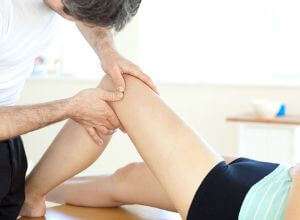
3. Regain Your Strength and Endurance
After restoring the range of motion, the next step will be regaining your strength. Your sports injury rehab specialist would teach you a variety of strength and endurance exercises that’ll push you to your limits without inducing additional harm. By ensuring you regain your strength levels, you’ll be able to reduce the risk of re-occurring injuries while moving closer to your peak athletic ability.
4. Higher Coordination Skills
Proper body coordination is the key to becoming a successful athlete. In the second to last rehabilitation stage, you’ll need to “re-teach” the injured area to work in partnership with other parts of your body. Your sports injury rehab specialist will assess how far you have come and consider what motions are used in your specific sport when developing a coordination regimen. Once your coordination has attained a healthy level, you’ll be able to move on to the final stage of the therapy.
5. Recovering Sports-Specific Movements
Your sports injury rehab specialist would have you perform exercises that mimic the specific motions you’d utilize when competing in your sport for the final rehabilitation stage. You won’t be able to return to your activities until you can perform all the motions you could before the injury took place. After completing this stage, you should feel confident that you can begin to compete again without fear of injury.
Benefits of Going to a Sports Injury Rehab Specialist
Sports medicine is an orthopedic medicine subspecialty. Commonly used to treat and target injuries to professional athletes, sports medicine could help anyone who has sustained a sports-related injury. Aside from helping you recover from an injury, it also has some unexpected benefits worth remembering. These include:
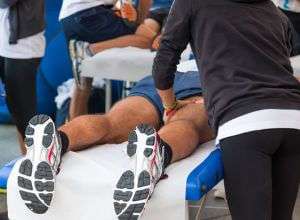
Rehabilitation – Sports medicine could be helpful for any physical injury. That includes injuries to your neck, shoulders, hips, back, knees, and ankles. Rehabilitation helps the injured area heal properly while retaining or increasing your range of motion and flexibility.
Stretches, exercises, and physical therapy are important to ensure the joint or area doesn’t stiffen. Other rehab areas include fall and balance therapy, massage, and occupational therapy. Aside from helping after an injury, rehabilitation with sports medicine can also help you improve your overall athletic performance.
You may not have performed at your full potential before due to overtraining, poor nutrition, or not properly warming up before or cooling down after your activity.
Consequently, injuries may not have healed properly before. However, sports medicine could strengthen both your muscles and joints. As a result, you could experience the rewards of better movement even if you are not an athlete.
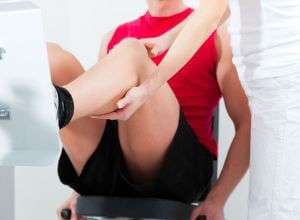
Preventive Care – Although rehabilitation is the primary focus of sports medicine, preventive care is crucial. The goal is to maintain and improve your health to avoid future injuries. That is accomplished through various wellness programs that include plenty of exercises and dietary discussions and information regarding nutritional benefits. This whole-body approach might even include some sports psychology.
A Wide Application – Sports medicine is made to diagnose, treat, heal, and manage injuries. But its countless treatments and exercises could be used for various injuries, illnesses, and other disorders.
This general approach, combined with specific therapies, makes sports medicine applicable to practically anyone. Whether you’re an athlete, only an occasional exerciser, or someone who’s not all that active, the principles of sports medicine could be used in multiple situations.
FAQ
How often should you rehab an injury?
The rule of thumb for those who have sports-related injuries is to start rehabilitation with range-of-motion exercises about 72 hours after the injury occurred, and it could continue for several weeks or even months.
What is a sports injury specialist?
A sports injury rehab specialist helps patients maximize function and minimize disability after a sports-related injury.
What is sports injury rehabilitation?
Sports injury rehabilitation is a kind of physical therapy that treats patients who have musculoskeletal system illness, pain, or injury. With the help of therapeutic interventions, exercises, and certain movements, sports injury rehabilitation aims to help you recover from sports-related injury and reduce discomfort and pain.

